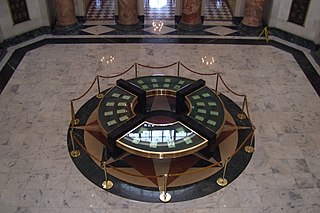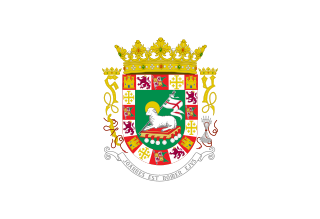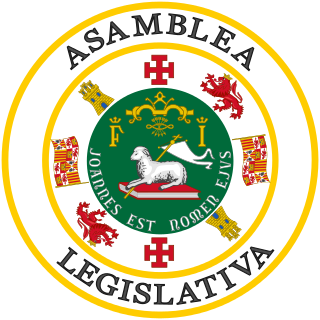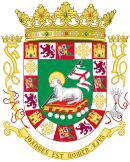
The politics of Puerto Rico take place in the framework of a democratic republic form of government that is under the jurisdiction and sovereignty of the United States Congress as an organized unincorporated territory. Since the 1898 invasion of Puerto Rico by the United States during the Spanish–American War, politics in Puerto Rico have been significantly shaped by its status as territory of the United States. The nature of Puerto Rico's political relationship with the United States is the subject of ongoing debate in Puerto Rico, in the United States, the United Nations and the international community, with all major political parties in the archipelago calling it a colonial relationship.

The Foraker Act, Pub. L. 56–191, 31 Stat. 77, enacted April 12, 1900, officially known as the Organic Act of 1900, is a United States federal law that established civilian government on the island of Puerto Rico, which had recently become a colony of the United States as a result of the Spanish–American War. Section VII of the Foraker Act also established Puerto Rican citizenship. President William McKinley signed the act on April 12, 1900 and it became known as the Foraker Act after its sponsor, Ohio Senator Joseph B. Foraker. Its main author has been identified as Secretary of War Elihu Root.

The government of the Commonwealth of Puerto Rico is a republican form of government with separation of powers, subject to the jurisdiction and sovereignty of the United States. Article I of the Constitution of Puerto Rico defines the government and its political power and authority. The powers of the government of Puerto Rico are all delegated by the United States Congress and lack full protection under the U.S. Constitution. Because of this, the head of state of Puerto Rico is the President of the United States.

The Constitution of the Commonwealth of Puerto Rico is the controlling government document of Puerto Rico. It is composed of nine articles detailing the structure of the government as well as the function of several of its institutions. The document also contains an extensive and specific bill of rights. It was ratified by Puerto Rico's electorate in a referendum on March 3, 1952, and on July 25, 1952, Governor Luis Muñoz Marín proclaimed that the constitution was in effect. July 25 is known as Constitution Day.

The governor of Puerto Rico is the head of government of the Commonwealth of Puerto Rico, and commander-in-chief of the Puerto Rico National Guard.

The Senate of Puerto Rico is the upper house of the Legislative Assembly of Puerto Rico, the territorial legislature of Puerto Rico. The Senate, together with the House of Representatives of Puerto Rico, control the legislative branch of the government of Puerto Rico.

The House of Representatives of Puerto Rico is the lower house of the Legislative Assembly of Puerto Rico, the bicameral territorial legislature of Puerto Rico. The House, together with the Senate, control the legislative branch of the government of Puerto Rico.

The Legislative Assembly of Puerto Rico is the territorial legislature of the Commonwealth of Puerto Rico, responsible for the legislative branch of the government of Puerto Rico. The Assembly is a bicameral legislature consisting of an upper house, the Senate normally composed of 27 senators, and the lower house, the House of Representatives normally consisting of 51 representatives. Eleven members of each house are elected at-large rather than from a specific legislative district with all members being elected for a four-year term without term limits.

Luis Guillermo Fortuño Burset is a Puerto Rican politician who served as the governor of Puerto Rico, an unincorporated territory of the United States, from 2009 to 2013.

Kenneth Davison McClintock-Hernández is a politician who served as the twenty-second Secretary of State of Puerto Rico, one of the four longest serving in that post. McClintock served as co-chair of Hillary Clinton’s National Hispanic Leadership Council in 2008, he co-chaired her successful Puerto Rico primary campaign that year and served as the Thirteenth President of the Senate of Puerto Rico until December 31, 2008. He chaired Luis Fortuño’s Incoming Committee on Government Transition in 2008 and the Outgoing Committee on Government Transition in 2012, the only Puerto Rican to serve in both capacities. He was sworn into office as secretary of state on January 2, 2009, by Chief Justice Federico Hernández Denton, fulfilling the role of lieutenant governor in the islands.

José Alberto Cabranes is an American lawyer who serves as a senior United States circuit judge of the United States Court of Appeals for the Second Circuit and a former presiding judge of the United States Foreign Intelligence Surveillance Court of Review ("FISCR"). Formerly a practicing lawyer, government official, and law teacher, he was the first Puerto Rican appointed to a federal judgeship in the continental United States (1979).

The Foreign Intelligence Service, or Serviciul de Informații Externe (SIE) in Romanian, is, under Law no. 1/1998, "the state body specialized in foreign intelligence concerning the national security and the safeguarding of Romania and its interests".
In the United States, a presidential transition is the process during which the president-elect of the United States prepares to take over the administration of the federal government of the United States from the incumbent president. Though planning for transition by a non-incumbent candidate can start at any time before a presidential election and in the days following, the transition formally starts when the General Services Administration (GSA) declares an “apparent winner” of the election, thereby releasing the funds appropriated by Congress for the transition, and continues until inauguration day, when the president-elect takes the oath of office, at which point the powers, immunities, and responsibilities of the presidency are legally transferred to the new president.

The secretary of state of Puerto Rico leads all efforts that promote the cultural, political, and economical relations between Puerto Rico and foreign countries, and other jurisdictions of the United States. The post was created by Article IV of the Constitution of Puerto Rico which merely establishes that the secretary serves as acting governor when the governor is unable to perform his duties—a post similar to that of a lieutenant governor in U.S. politics. In recent times, however, the post has evolved into one similar to that of a foreign minister. Today, the secretary is the officer in charge of Puerto Rico's foreign relations, albeit under the consent of Congress or the U.S. Department of State due to Puerto Rico's political status.

The political status of Puerto Rico is that of an unincorporated territory of the United States officially known as the Commonwealth of Puerto Rico. As such, the island of Puerto Rico is neither a sovereign nation nor a U.S. state. It is because of that ambiguity, the territory, as a polity, lacks certain rights but enjoys certain benefits that other polities have or lack. For instance, in contrast to U.S. states, Puerto Rico residents cannot vote in U.S. presidential elections nor can they elect their own senators and representatives to the U.S. Congress. On the other hand, in contrast to U.S. states, only some residents of Puerto Rico are subject to federal income taxes. The political status of the island thus stems from how different Puerto Rico is politically from sovereign nations and from U.S. states.

Alejandro Javier García Padilla is a Puerto Rican politician and attorney who served as the governor of Puerto Rico from 2013 to 2017.
A referendum on the political status of Puerto Rico was held in Puerto Rico on November 6, 2012. It was the fourth referendum on status to be held in Puerto Rico. Puerto Rico has been an unincorporated territory of the United States since the Spanish–American War in 1898.
There are differing points of view on whether Puerto Rico's current political status as a territory of the United States should change. Four major viewpoints emerge in principle: that Puerto Rico maintains its current status, becomes a US state, becomes fully independent, or becomes a freely associated state.

The Puerto Rico governmental line of succession defines who may become or act as Governor of Puerto Rico upon the incapacity, death, resignation, or removal from office of a sitting governor or a governor-elect.
The 2012 Puerto Rico government transition process is the ongoing process in Puerto Rico regarding the government transition between the outgoing governorship of incumbent Governor Luis Fortuño and the incoming governorship of Alejandro García Padilla, governor-elect. The process is mandated and regulated by Law No. 197 of 2002 and started on November 13, 2012, three working days after the Puerto Rican general election of 2012 as the law requires, once García Padilla was preliminarily certified as Governor-elect by the State Elections Commission.













